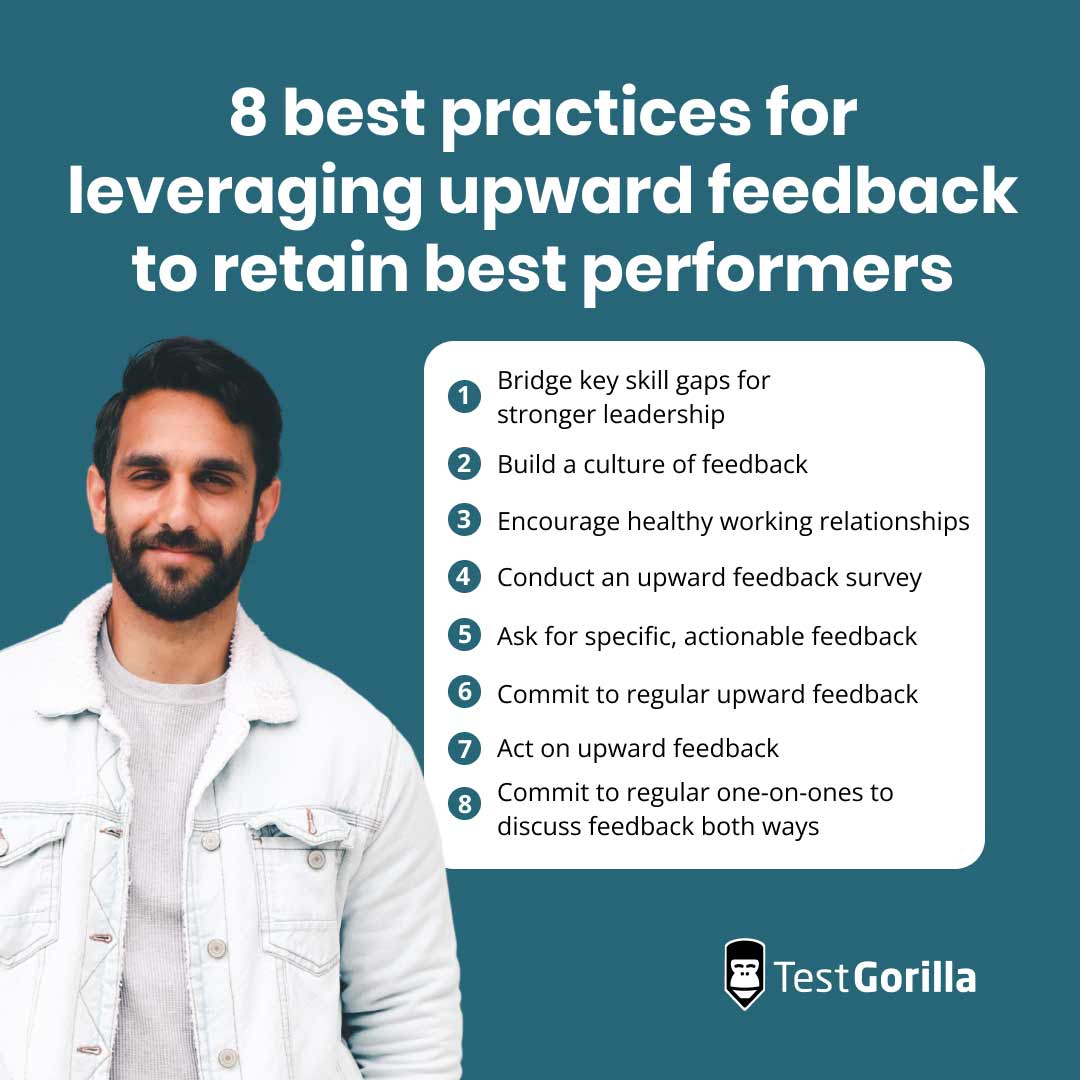Upward feedback: Leverage this talent retention trend to improve job satisfaction
Good leadership is crucial for company success. It impacts productivity, profitability, employee satisfaction, and retention, helping shape the workplace culture.
However, only 48% of employees and managers think their company’s leadership is high-quality.[1]
When employees don’t believe their managers are good enough to lead, it can negatively affect their productivity and motivation to work, leading them to seek out other opportunities.
How can you ensure the right leadership and people management in your business?
One important part of the equation is having your managers listen to employees and understand their needs and aspirations. That can be done through upward feedback, an employee retention trend that enables workers to voice concerns, give feedback to seniors, and communicate about their roles.
Let’s see what upward feedback is, the benefits of upward feedback, how to give upward feedback, upward feedback examples, and how this trend can shape your overall employee retention strategy.
Table of contents
- What is upward feedback?
- Why is upward feedback important?
- The benefits of upward feedback
- 6 examples of upward feedback
- 8 best practices for leveraging upward feedback to retain your best performers
- Giving upward feedback: 4 examples of companies succeeding with this talent retention trend
- Use upward feedback to improve workplace satisfaction
What is upward feedback?
Upward feedback is an important trend in which employees give insights about their supervisor’s performance, management style, and behavior. Unlike traditional feedback, this model facilitates a two-way dialogue, enabling employees to share their thoughts and supporting organizational growth.
Upward feedback is vital because it bridges the gap between the frontline experiences of lower-level employees and the strategic decision-making of managers and higher-ups.
It can be given at various times, depending on the organization’s culture and structure, including during:
Regular employee performance reviews
One-on-one meetings
Anonymous employee surveys
Scheduled upward feedback sessions
Why is upward feedback important?
Upward feedback gives employees a voice, enabling them to share thoughts, concerns, and suggestions. This has empowering effects, fostering a sense of ownership and contribution to the company.
In addition, seeking and appreciating upward feedback makes employees feel heard and valued. Their opinions become an important part of shaping the work environment, which signals that each input is recognized and respected.
For employers, upward feedback is an excellent method for uncovering potential blind spots in leadership.
It brings to light subtle issues, like a manager’s seemingly harmless humor that may contribute to a negative work environment and employee dissatisfaction. These issues often only get recognized when they escalate, leading to employee burnout, disengagement, and even higher employee turnover rates.
Upward feedback also supports diversity in the workplace by encouraging employees to share their opinions and perspectives. Getting the insights of all of your employees can help make positive changes in your business because these diverse ranges of views often lead to innovative solutions.
Lastly, upward feedback practices are a great way to discover leadership talent in your workforce. That’s because employees who give fair, insightful feedback may possess the right skills to move into a leadership position.
The best insights on HR and recruitment, delivered to your inbox.
Biweekly updates. No spam. Unsubscribe any time.
The benefits of upward feedback
Here are some of the main advantages upward feedback brings to companies and HR professionals:
1. Better employee retention
Managers play a crucial role in how employees feel about their jobs. People often quit because of their bosses, not because they are unhappy with the company.
In fact, 57% of employees have left a job because of their manager. To make things even worse, 14% have left multiple positions for the same reason, and another 32% have considered quitting because of management issues.
It’s obvious that there is a lack of communication between employees and managers, and upward feedback bridges that gap.
As many as 90% of employees state they are likely to stay in a company that takes and acts on feedback. Unfortunately, according to the same study, 15% of employees never get to share their perspectives, and another 43% only get to share their feedback once or twice a year.
Making upward feedback a part of your workplace is one step to building a good company culture, making employees feel more satisfied, and preventing voluntary turnover.
2. Improved job satisfaction
Relationships between employees and their managers are crucial for a happy workplace. Unfortunately, these relationships often have issues.
For example, 75% of employees recognize their immediate supervisor as the most stressful aspect of their job.[2]
Managers are essential for employee satisfaction, but the main problems arise when they have unclear expectations, don’t provide feedback, and show a lack of support and consideration for employee wellbeing.
Upward feedback enables employees to raise their concerns and prevent the issues from escalating. It fosters a constructive dialogue that improves employee-manager relationships and addresses the root cause of dissatisfaction before it turns into something bigger.
3. Better employee engagement
Managers shape how engaged their team is by keeping them in the loop, setting priorities, managing expectations, and providing regular feedback.
It’s no wonder that 70% of employees say their manager significantly impacts how engaged their teams are.
Having a great boss makes all the difference because those with the best bosses are 2.5 times more likely to be fully engaged. They go the extra mile, support the company, and stick around longer on average. The reason for this is simple – when employees feel supported and trust their manager, it boosts their motivation and loyalty. So, what makes a good manager? Many behavioral competencies and skills that determine whether someone can be a good manager. But one of the most important abilities is to actively listen to employees and act on their insights. That’s where upward feedback helps because this employee retention trend installs a culture of continuous communication in your organization.
4. Improved company performance
Companies with effective communication programs are 3.5 times more likely to perform better than their competitors. That’s because good workplace communication can offer insights, create a more collaborative environment, and support full transparency.
Upward feedback supports communication between employees and managers, breaking down the main communication barriers. But it’s not just about talking – it’s about transforming these insights into practices for success.
Upward feedback enables managers to align strategies with on-the-ground insights, address issues proactively, and make informed decisions.
As a result, these practices promote better workplace collaboration and communication, ensuring everyone is on the same page regarding your company’s success. It can also improve employee wellness, because workers feel heard and valued.
6 examples of upward feedback
It’s important to hear your employees and understand what their input means.
Feedback from employees may not always be 100% clear. It’s important to be able to translate less explicit feedback and transform it into constructive criticism because it can hint at underlying problems.
Here are six examples of positive and negative upward feedback and what they can mean for you from an HR perspective:
Focus | Upward feedback examples | What it means |
Workload, burnout, and work-life balance | “I’ve been exploring strategies for more efficient time management.” | Suggests a discreet concern about workload without directly expressing burnout, hinting at a need for a more balanced work environment |
Positive appreciation | “It’s always motivating to see the team’s efforts recognized.” | Implies a desire for more positive feedback without explicitly stating it, emphasizing the importance of acknowledgment for team morale and motivation |
Asking for clarification | “I’ve been revisiting our project goals and need clarification on the most important objectives.” | Indicates a need for clearer communication without explicitly stating confusion |
Asking for recognition | “Celebrating small wins can contribute to a more positive workplace atmosphere.” | Suggests a desire for more recognition without explicitly expressing dissatisfaction |
Sharing grievances about peers | “Some team members are discussing recent changes.” | Provides subtle cues about collective dissatisfaction without explicitly stating grievances, suggesting an outlet for addressing concerns |
Expressing concerns over different work styles | “I could benefit from a more collaborative work environment that doesn’t rely exclusively on individual talents.” | Implies an independent work culture with lack of communication that can cause stress and frustration for the employee |
8 best practices for leveraging upward feedback to retain your best performers
Upward feedback for managers is one of the best ways to understand your employees’ needs and wants and improve their retention.
Here’s how to leverage this talent retention trend to keep your employees happy and performing well.
Summary of how to leverage upward feedback
Tip | Summary |
1. Bridge key skill gaps and create stronger leadership | - Identify manager skill gaps and use talent assessments to design targeted professional development plans |
2. Build a culture of feedback from all sides | - Create a culture of feedback in the workplace by encouraging communication and recognition |
3. Encourage healthy working relationships | - Promote open communication, teamwork, and recognition to promote positive workplace relationships - Emphasize the constructive nature of employee input and educate teams on its importance |
4. Conduct an upward feedback survey | - Implement structured upward feedback surveys to gather insights on managerial performance, promoting transparency and accountability - Use anonymity to encourage honesty |
5. Ask for specific, actionable feedback | - Encourage employees to provide specific, solution-oriented, and measurable feedback - Guide them to address issues constructively and improve vague or unconstructive feedback |
7. Commit to regular upward feedback sessions/surveys | - Schedule regular feedback sessions, supporting real-time insights and strengthening communication |
8. Make an effort to act on upward feedback | - Develop a systematic approach to collect, categorize, and prioritize feedback - Transparently communicate and execute action plans, celebrate milestones - Seek follow-up feedback for continuous improvement |
9. Commit to regular one-on-ones to discuss feedback both ways | - Conduct regular one-on-one meetings to improve employee-manager relationships, support internal growth, address concerns, recognize individual value, and boost overall team engagement |
1. Bridge key skill gaps and create stronger leadership
Upward feedback from the team gives you the information you need to strengthen your leaders. After processing and analyzing employee insights, you may discover that managers could work on upskilling specific skills.
For example, upward feedback may indicate managers lacking communication skills or empathy. Talent assessment tests confirm this, underlining the specific areas for improvement. These insights motivate the manager to undergo targeted communication and empathy training, helping develop these crucial skills.
By combining upward feedback and talent assessments, you can create a professional development plan, diving deep into the core of leadership issues and outlining a path to tackle those issues.
Subsequent upward feedback demonstrates significant improvements, resulting in better clarity, fewer miscommunications, and better team productivity.
2. Build a culture of feedback from all sides
Most companies use performance evaluations to discuss employee’s accomplishments during a specific period. However, performance evaluations only occur once or twice a year and don’t consider employee’s input.
Regular employee feedback is much more effective because it helps set expectations, track performance, and locate potential areas of improvement.
Encouraging continuous employee and upward feedback helps build an inclusive culture of transparency, communication, and employee recognition. It helps create a dynamic feedback loop that supports collaboration and growth.
However, some employees may hesitate to share upward feedback directly with their supervisors due to potential discomfort or fear of repercussions. You can overcome this by creating anonymous feedback channels that protect employees and ensure their honest input.
The key to this is cultivating psychological safety at work. In a psychologically safe workplace, employees feel free to voice concerns, ask questions, and share opinions without fear of negative consequences. Such an environment enables upward feedback to have the most benefits.
3. Encourage healthy working relationships
Strong working relationships are about more than camaraderie; they’re a way to create positive workplace growth. Healthy relationships urge managers to put the ego aside, helping them accept feedback and adapt more willingly.
As a result, everyone becomes more open, supporting flexibility in the workplace. In addition, a collaborative atmosphere improves teamwork, driving everyone to work harder towards shared goals.
Here’s how you can support healthy working relationships:
Encourage team members to express ideas, concerns, and feedback openly
Emphasize teamwork, ensuring that individuals feel supported in their roles
Recognize and appreciate contributions regularly to promote a positive environment
Organize team buildings and other activities to share experiences and strengthen bonds
Educate teams on the constructive nature of feedback and the importance of it
4. Conduct an upward feedback survey
Upward feedback surveys provide a structured channel for employees to share insights about their managers, promoting transparency and accountability. These surveys are important because they use a systematic approach to collect data, creating a comprehensive view of managerial performance.
Consistent surveys empower organizations to identify trends over time, pinpointing areas of improvement and success within leadership. Offering anonymity encourages honest feedback, creating a safe space for employees to express opinions without fear of reprisal.
The most important thing about these surveys is to create a good structure and choose the right upward feedback questions. You can ask direct questions like:
What do you see as your manager’s greatest strengths?
Can you provide examples of how your manager has positively impacted the team?
In which areas do you think your manager needs improvement?
Are there specific skills or qualities that could improve your manager’s effectiveness?
Or you could ask more open-ended questions to identify potential problems and receive more out-of-the-box solutions. For example:
Is there anything you like or appreciate about your manager’s approach or performance?
How do you think your manager could better support the team’s success?
5. Ask for specific, actionable feedback
Effective feedback doesn’t point fingers. Instead, it provides actionable, specific steps that drive a positive change. Unfortunately, many people are not good at giving or receiving feedback. That’s why you need to encourage the type of feedback that gives valuable insights and ask more questions to clear up bad feedback.
You should ensure your leaders are giving good feedback, and employees should follow suit. If you have leaders who are pointing fingers, employees are also going to start pointing fingers because that’s the culture you’ve established.
That’s why it is vital to foster a good company culture based on specific, solution-oriented, measurable feedback.
Good feedback should be specific.
For example, instead of “Andrew’s always too busy to see me,” you should encourage feedback like “I could communicate better if we got our regular 1:1 meeting, but Andrew often needs to reschedule.” The first option is vague and lacks clarity on what needs improvement. The second feedback addresses the core root of the problem.
Feedback should also be solution-oriented.
For instance, instead of comments like “I don’t like our current workflow,” you should encourage feedback like “Implementing a project management tool can streamline our workflow and improve productivity.” The first option is negative feedback that fails to provide any solutions. The second bit of feedback focuses on a specific way the team can use to overcome their common problem.
Lastly, you should encourage your employees to give measurable feedback and avoid generalizations.
For example, instead of “Our meetings are always unproductive,” a better option would be “Meetings can be more productive if we establish a clear agenda and time limits.”
6. Commit to regular upward feedback sessions/surveys
The common practice for upward feedback is to receive it once a year. However, committing to regular feedback sessions helps create an atmosphere of mutual understanding and continuous improvement.
You can opt for quarterly, monthly, bi-weekly, or weekly feedback. This proactive approach keeps everyone in the loop, maintains a real-time pulse on employee sentiments, and strengthens the collaborative bond between employees and leadership.
So, why is that important?
Regular upward feedback ensures that insights are current, enabling the organization to adapt swiftly to evolving conditions. This practice also uncovers dissatisfaction and prevents it from growing stronger and escalating to disengagement, burnout, or higher employee attrition rates.
In addition, consistent feedback sessions foster a culture of open communication, making it a natural part of the workplace rather than a sporadic occurrence.
A great example is a case study of a plant manager, John Welsh, who started weekly feedback sessions with his workers. Welsh meets with them every Monday and answers all their questions during breakfast. These weekly meetings have helped identify problems, improve training, create at least $500,000 in cost savings, and deal with the COVID-19 pandemic more effectively.[3]
7. Make an effort to act on upward feedback
Requesting upward feedback is the first step, but you need to act on it to show your employees you value and respect their input. Implementing a systematic approach to addressing feedback is a great way to ensure managers work on it.
Here’s how you can do that:
Collect and organize feedback from various channels, including surveys, one-on-one sessions, and anonymous submissions
Categorize feedback into themes, identifying recurring patterns and specific areas for improvement
Determine which actions can bring the most benefits and prioritize insights based on its impact and urgency
Develop precise, actionable strategies for each identified area, outlining clear steps, timelines, and goals
Communicate the action plan transparently to the team, sharing objectives, expectations, and timelines
Execute the action plan with commitment and diligence, ensuring effective implementation
Regularly track progress and adjust strategies as necessary
Celebrate achieved milestones
Seek follow-up upward feedback to confirm improvements and ensure continuous growth
8. Commit to regular one-on-ones to discuss feedback both ways
One-on-one meetings are personalized sessions between managers and team members where they discuss anything from project needs and team performance to career growth.
These sessions are different from regular team meetings because they provide an opportunity for managers and employees to connect on an individual level.
One-on-one meetings are vital for supporting workplace communication and teamwork. These sessions are great opportunities for leaders to give constructive feedback and gather valuable insights from employees.
According to a Microsoft study, employees who don’t get a chance for regular 1:1 meetings are twice as likely to view their leadership in a more negative light.[4]
One-on-one meetings have several benefits:
Improving employee-manager relationships
Supporting internal growth
Discussing concerns and relevant information timely
Discovering difficulties and project roadblocks
Recognizing individual value
Uncovering talent potential
Boosting team engagement
Improving employee retention rates
Developing better leadership skills
Giving upward feedback: 4 examples of companies succeeding with this talent retention trend
Upward feedback has become an important trend in talent retention, enabling organizations to understand and address employee needs.
Here are four mini case studies of companies that have successfully leveraged an upward feedback process to improve talent engagement and retention.
Summary of how these 4 successful companies use upward feedback
Company | Summary |
Lincoln Financial | The business implemented an “employee listening” approach to address worker needs, which made 76% of employees feel like they could grow within the company. |
RX Global | The company balances upward feedback collection with active employee involvement in action planning, resulting in an improved overall employee experience and long-term retention. |
The tech giant uses standardized upward feedback surveys with quantitative and qualitative questions. The goal is to improve manager performance, communication, and goal setting, contributing to higher employee satisfaction. | |
British Petroleum | The organization implemented an upward feedback system in the late 80s to support leadership behavior changes. It resulted in improved employee satisfaction and leadership effectiveness. |
Lincoln Financial
Lincoln Financial has implemented an “employee listening” strategy to help understand the needs of its employees. This approach nurtures conversations and active listening of the employees, which helps direct organizational focus.
Employee listening incorporates components like employee feedback surveys, focus groups, one-on-one meetings, and action planning. More importantly, the company acted on this valuable feedback and incorporated it into its future plans.
The surveys showed that employees wanted learning and development opportunities. So, Lincoln Financial made the effort to implement more growth for its employees.
After implementing the employee listening approach, 76% of employees felt they could grow within the company. That has significantly improved the company’s employee retention efforts.
RX Global
RX Global is a great example of a company that has successfully turned upward feedback into meaningful action capable of improving employee engagement and retention. Its secret: a careful balance between collecting feedback and including its employees in the planning.[5]
The company carefully surveys its employees and includes them in the action planning and implementation. This inclusive approach ensures that employees are not just contributors but also active participants in problem-solving.
By addressing issues raised through feedback and demonstrating a genuine commitment to improvement, the organization improves the overall employee experience. That increases the chances of employees staying with the company over the long term.
Google is a leader in leadership development and innovation. The company has used standardized upward feedback surveys to learn from its teams and tackle burning questions and problems.
Employees fill out upward feedback surveys twice a year. These questionnaires consist of 11 quantitative statements that cover the most important objectives.
Here are some examples:
My manager gives me actionable feedback that helps me improve my performance.
My manager regularly shares relevant information from his/her manager and senior leaders.
My manager communicates clear goals for our team.
In addition, there are two open-ended questions to give employees a chance for more qualitative answers:
What would you recommend your manager keep doing?
What would you have your manager change?
All survey responses are confidential, and managers receive a report of anonymous, aggregated feedback. This upward feedback system has helped the company support managers and keep its employees happy.
British Petroleum
During the late 80s, British Petroleum (BP) was going through turbulent times. It concluded that to survive, the company needed to become less bureaucratic and more cooperative. That’s why it started using upward feedback to support desired changes in leadership behavior.[6]
The company initiated a comprehensive upward feedback system involving employees providing input to their managers. The process aimed to uncover blind spots, improve leadership communication, and foster a more inclusive workplace.
Following the implementation, BP observed a significant improvement in employee satisfaction and leadership effectiveness. Equipped with actionable insights from upward feedback, managers adjusted their approaches, addressing employee concerns and creating a more positive, supportive work environment.
Use upward feedback to improve workplace satisfaction
Upward feedback is a vital employee retention trend that gives employees a voice, making them feel more valued. That improves job satisfaction, employee engagement, performance, and retention.
Leveraging upward feedback helps you bridge leadership skills gaps, cultivate feedback culture, encourage healthy work relationships, acquire actionable insights, translate feedback into action, and promote organizational growth.
If you want to create better leaders, you can use our skills and personality tests to find the most pressing areas for improvement.
You can also learn more about employee voice and why you should start paying more attention to what your workers have to say.
Sources
1. “Global Leadership Forecast”. (2021). Development Dimensions International. Retrieved November 22, 2023. https://www.ddiworld.com/global-leadership-forecast-2021
2. “Stress is killing you”. (August 2014). Everest College. Retrieved November 22, 2023. https://www.hoganassessments.com/wp-content/uploads/2014/08/Stress_Health_eBook_Final.pdf
3. Thomas, Kiara. (April 22, 2022). “A Case Study: Regular One-To-One Chats with Direct Reports & Hourly Staff”. LinkedIn. Retrieved November 22, 2023. https://www.linkedin.com/pulse/case-study-regular-one-to-one-chats-direct-reports-hourly-thomas/
4. Shikaloff, Nina; Fuller, Ryan. (February 2, 2017). “What great managers do daily”. Microsoft Workplace Insights. Retrieved November 22, 2023. https://workplaceinsights.microsoft.com/productivity/what-great-managers-do-daily/
5. “Companies that Harness The Power of Employee Feedback to Improve Retention”. (February 28, 2023). Comparably. Retrieved November 22, 2023. https://www.comparably.com/blog/companies-that-harness-the-power-of-employee-feedback-to-improve-retention/
6. Kettley, Polly. (1997). “Personal feedback: Cases in point”. The Institute for Employment Studies. Retrieved November 22, 2023. https://www.employment-studies.co.uk/system/files/resources/files/326.pdf
You've scrolled this far
Why not try TestGorilla for free, and see what happens when you put skills first.



















